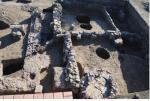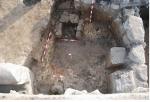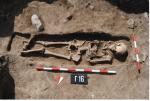Summary (English)
PLISKA (Stanislav Ivanov – stanislavivanovarh@gmail.com) The northern half of the Palatial Square was explored. The square was situated between the southern fortification wall of the Citadel built of bricks and the Palatial Church / the Proto-Bulgarian Pagan Temple. The last rooms of Building No. 2, consisting of parallel rooms arranged in a line, were discovered. An oven with U-like layout, built of bricks and 1.70 m by 1.30 m in size, was explored. Three semi-dug sunken-floored houses and nine related storage pits were discovered. House No. 1 was 4.50 m by 3.20 m in size and had a stove built of bricks. House No. 2 was 4.80 m by 4 m in size and had a stove built of bricks. House No. 3 had a quadrilateral layout and was c. 4.50 m wide, with a stove built of bricks. Twenty Christian burials belonging to the necropolis of the Palatial Church were discovered. Thus the total number of the burials discovered so far reached 33. The deceased woman buried in grave No. 16 had three glass bracelets on her left hand and a silver earring was found under the skull. A child was buried in grave No. 21 and the grave goods included two bronze appliqués, glass beads and two glass bracelets. Another child was buried in grave No. 22 with two glass bracelets on its right hand and three glass bracelets on its left hand. Pits from timber posts and a trench, 70 cm wide, for a timber fence with posts c. 20 cm wide were explored. Building No. 2 is the latest structure in the complex. Judging from the coins and the finds, it dated to the end of the 10th – 11th century. The sunken-floored houses and the storage pits preceded the construction of Building No. 2. The necropolis also dated to the Post-Capital period, while the pits and the trench dated to the Capital period of Pliska.
- Stanislav Ivanov - Shumen Branch of the Archaeological Institute and Museum
Director
Team
Research Body
- Shumen Branch of the Archaeological Institute and Museum






![Download [PDF]](/excavation/skins/fasti/images/results/download_sml.png)

